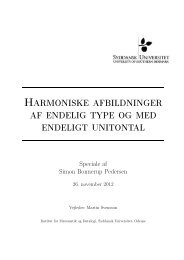Slides from the talk - CP3-Origins
Slides from the talk - CP3-Origins
Slides from the talk - CP3-Origins
You also want an ePaper? Increase the reach of your titles
YUMPU automatically turns print PDFs into web optimized ePapers that Google loves.
What about o<strong>the</strong>r models?<br />
approach [40]<br />
∆b I = b NG<br />
1 − b G 1 = − ∂ ln RNG (M)<br />
, (6.5)<br />
∂δ c<br />
The scale-dependence of bias can be different<br />
for o<strong>the</strong>r models, or not be <strong>the</strong>re at all ...<br />
R NG (M) being <strong>the</strong> ratio of <strong>the</strong> non-Gaussian to <strong>the</strong> Gaussian mass function. Here,<br />
ver, we treat ∆b I as a free parameter and compare it later on with <strong>the</strong> prediction<br />
ed <strong>from</strong> <strong>the</strong> mass functions. We choose q as <strong>the</strong> second free parameter. All o<strong>the</strong>r 1<br />
tities in Eq. (6.4) are we derive <strong>from</strong> <strong>the</strong> <strong>the</strong>ory and are kept fixed.<br />
In Fig. 8, we show as an example <strong>the</strong> effect of local non-Gaussianity on <strong>the</strong> halo bias<br />
alos of mass 1.2 − 2.4 × 10 14 M ⊙ /h at z = 0. Note that we plot ∆b(k)+0.1. As ∆b I is<br />
tive, this addition of 0.1 is needed to still make use of <strong>the</strong> logarithmic scale.<br />
The different line types visualize <strong>the</strong> effect of <strong>the</strong> different terms in Eq. (6.4). The 0.1<br />
s lines show <strong>the</strong> best fit to <strong>the</strong> data (using all modes up to k max =0.1Mpc/h) and<br />
des all terms given above. The short-dashed lines neglects ∆b I appearing inside <strong>the</strong><br />
re brackets in Eq. (6.4). The inclusion of this term makes <strong>the</strong> non-Gaussian bias nonr<br />
in f NL [55], since ∆b I depends on f NL . The dot-dashed line neglects ∆b I completely.<br />
scale-dependent bias shift becomes important on smaller scales (k >0.02), for which<br />
cale-dependent part becomes small.<br />
!b + 0.1<br />
10<br />
1<br />
0.1<br />
1<br />
k<br />
Orthogonal orthogonal NG<br />
Gaussian bias. This has <strong>the</strong> advantage that by doing this we do not need to include β(k<br />
<strong>the</strong> modelling of ∆b(k) (seeEq.(2.1) and Eq. (2.4)).<br />
!b + 0.1<br />
0.4<br />
f NL = -1000<br />
1.2x10 14 < M<br />
f NL = -250<br />
halo < 2.4x10 14<br />
3x10 13 < M halo < 6x10<br />
Figure 8. Local non-Gaussian bias of halos with mass 1.2 × 10 14 Mpc/h < 13<br />
M < 2.4 × 10 14 M<br />
at z = 0. The difference of <strong>the</strong> bias measured <strong>from</strong> <strong>the</strong> non-Gaussian simulations and Gau<br />
simulations is depicted 0.2 by <strong>the</strong> data points (for computation of <strong>the</strong> errorbars, see App. B). The<br />
lines show <strong>the</strong> best fit using <strong>the</strong> model given in Eq. 6.4. The dot-dashed lines show <strong>the</strong> m<br />
predictions when <strong>the</strong> scale-independent bias shift, ∆b I , is neglected. The short-dashed lines ne<br />
<strong>the</strong> term which is non-linear 0 in f NL (see text for details). Thick lines and red symbols correspon<br />
f NL = 250, while thin lines and blue symbols show <strong>the</strong> results for f NL = 60. Note that we act<br />
show ∆b +0.1 to allow for a logarithmic scale.<br />
!b<br />
10<br />
0.01<br />
0.003 0.01 0.1<br />
-0.2<br />
-0.4<br />
1<br />
k 2<br />
local<br />
Local NG<br />
k [h/Mpc]<br />
f NL = 250<br />
f NL = 60<br />
As <strong>the</strong> non-Gaussian and <strong>the</strong> Gaussian simulation share <strong>the</strong> same realization of<br />
initial Gaussian field, ∆b(k) is almost free of sample variance and, in addition, has sm<br />
shot noise than b NG (k) and b G (k) individually. We estimate <strong>the</strong> error on ∆b(k) directly f<br />
const.<br />
<strong>the</strong> distribution of ∆b(k) in each k bin (for details, see App. B).<br />
Following Eq. 2.1, wemodel∆b(k) by equilateral<br />
Wagner & Verde (2010)<br />
Equilateral NG<br />
0.01<br />
0.003 0.01 0.1<br />
k [h/Mpc]<br />
where b G 1<br />
<br />
∆b(k) =∆b I + f NL b<br />
G<br />
1 + ∆b I − 1 qδ c F M (k)<br />
D(z) M M (k) , (<br />
-0.6<br />
0.003 0.01 0.1<br />
k [h/Mpc]<br />
is <strong>the</strong> linear halo bias obtained <strong>from</strong> <strong>the</strong> Gaussian simulation on large scales








